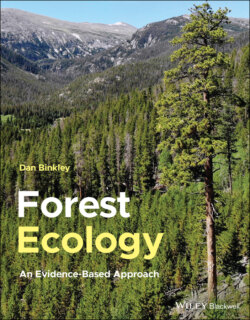Читать книгу Forest Ecology - Dan Binkley - Страница 19
CHAPTER 1 The Nature of Forests
ОглавлениеTo see a World in a Grain of Sand,
And a Heaven in a Wild Flower,
Hold Infinity in the palm of your hand,
And Eternity in an hour.…
William Blake (1757–1827)
William Blake's poetic approach of seeing the general in the specific is a useful approach, two centuries later, for launching into the ecology of forests. The biology of a single tree in a single hour connects outward in time to the course of the tree's development from a seed, back through evolutionary time for the genes comprising the tree's genome. The environmental influences on the tree also connect outward in space, with strong similarities to the forces shaping trees around the world. The value of this literary approach to describing and understanding forests has limits: trees comprise the greatest part of the living matter within a forest, but the vast majority of organisms and species in forests are not trees at all. The biodiversity of forests resides primarily in understory plants, animals, and especially very small organisms such as arthropods, fungi, and bacteria.
The ecology of forests can be explored using Blake's approach of starting very small to begin to understand very large and complex systems. The hourly, daily, and annual story for a single tree can be expanded outward to encompass the other trees in a forest, a landscape, and the forest biome, just as an hour can be expanded to a day, a year, a millennium, and evolutionary timescales.
